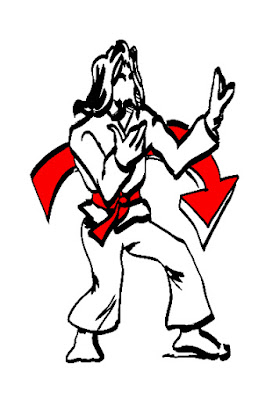In many cases of martial arts the execution of the moves is often very square-like; this has a lot to do with the tradition of the training of the form having had such importance over the centuries.
When doing some external styles a typical situation would be this: you're blocking the opponent's hand moving in, be it a punch of a grabbing attempt. What we call a block here is really a strike as we change the direction of the attack by hitting with the thick bone of the forearm, uchi-uke that would be. Depending on the distance we may either step in or move one foot back in order to have a stronger basis, and while blocking we also pull the other arm to the side so the fist is ready for an immediate counter-strike. We're talking high-energy techniques here.
The problem might be that to block the attack your arm must be a) stronger b) faster than that of the opponent. One is to realize that an essential part of the external styles is increasing strength and toughness, such qualities should really be taken to the level of an Olympic athlete. Be not fooled by any commercial marketing while seeking practicality in the art; it's one thing to own a gun and another to have bullets in it. Then again you might want to take the force to the extreme anyway, but don't forget that creating distance in that search also creates time, not just for you but for the opponent to react as well.
Sometimes we do not have the time to test our speed to begin with. Say we're taken by surprise and hopelessly late, then we should go Wudang instead. We bring the hand right up and while guiding the opponent's arm rotate our body to avoid the advancing amount of energy. It's not so much about pushing the oncoming attack to the side but moving away from it. And as we turn our shoulder line the free hand's automatically taken nearer to the opponent, so apart from using it to shove the elbow and thus add that to what the blocking hand is doing, we can go straight for the face or the throat. There are two significant matters: the counter-attack coming (almost) at the same time as the block's being done, and not too much force that might "warn" the opponent of what's happening next being directed towards the person in question.
 |
| Even Masutatsu Oyama preferred circular movement in creating energy |
Let us think of a situation of even greater disadvantage. We've had our back turned, and from the corner of the eye see that someone's there, an attack coming. We don't really have time to rearrange, no formations to be done - so the first thing now is to move in, away from the line of the attack and towards the opponent. We also want to have our head protected of course, but there's not much space for the inner arm as the punch is already on the way. What I would do is use the other arm, bring it up and wrap it around the head, nice and tight, like a constrictor. I think of touching the back of my head with the back of my hand to make it safe for whatever might follow. In case you only choose to cover your face with the forearm and the latter's actually hit you probably end up punching/slapping yourself. You might have a thumb in your eye or the blade of the wrist busting your teeth. And so on.
One important thing to remember is to keep your palm turned away from you. See there's this cup-like shape in it, so if the strike connects and the hand smacks the ear the air inside the cup causes pressure that can be enough to blow the drum. That then may have an effect to the balance.
Once the cover's tight you've actually turned the target into a weapon. What I mean by this is the stepping in; you want to have the tip of your elbow hitting the opponent in the face. In a perfect world we'd obviously be delivering an elbow-strike instead, but this time we must settle for closing in that part first, the arm glued to the head, the body working as a unit. It is the opponent's movement that makes it dangerous for him/her; keep in mind that the enemy's charging. If you're worried about getting yourself in a headlock-type of hold with your arm trapped across your face, it is the aggressive nature of your own technique that gives you the advantage, so you'll be able to make traps out of the opponent's efforts. Never be happy with only making it half-way there, it's no less than the scalp that brings victory.
Being more powerful in the spirit is the essence of being more powerful in the collision, though on the other hand we must keep comprehending the facts that build the reality around us. In comparison, the force of the upper body techniques emerges from the lightness of the feet, speaking of which I'd like to give another example by using a metaphor of walking: going step by step in combat means wasting time and expecting the opponent to make mistakes, striding into the battle and hoping for the best. But when you have the flow it's like placing the heel of one foot to the toes of the other, more things happening within the same period of time. Then again the secret of Wudang is having your feet next to each other and moving either one when it's needed, as far as is needed. Through the perception of space and time make all action take place as simultaneously as possible, through the perception of the dimensions make the process your very domain.